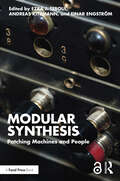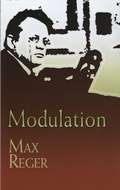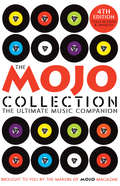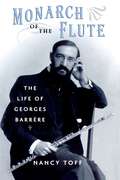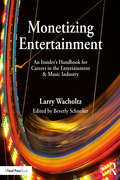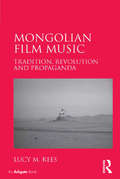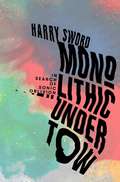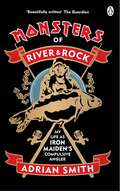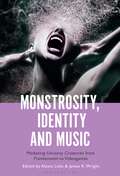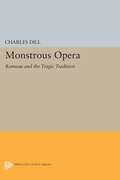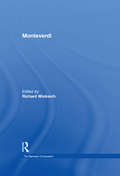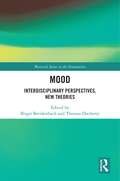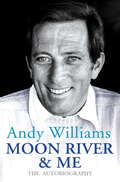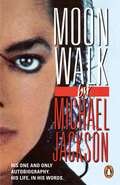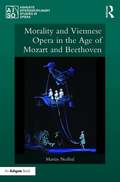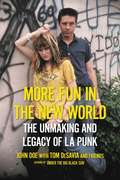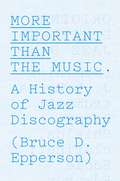- Table View
- List View
Modular Synthesis: Patching Machines and People
by Ezra J. Teboul Andreas Kitzmann Einar EngströmModular Synthesis: Patching Machines and People brings together scholars, artists, composers, and musical instrument designers in an exploration of modular synthesis, an unusually multifaceted musical instrument that opens up many avenues for exploration and insight, particularly with respect to technological use, practice, and resistance.Through historical, technical, social, aesthetic, and other perspectives, this volume offers a collective reflection on the powerful connections between technology, creativity, culture, and personal agency. Ultimately, this collection is about creativity in a technoscientific world and speaks to issues fundamental to our everyday lives and experiences, by providing insights into the complex relationships between content creators, the technologies they use, and the individuals and communities who design and engage with them.With chapters covering VCV Rack, modular synthesis, instrument design, and the histories of synthesizer technology, as well as interviews with Dave Rossum, Corry Banks, Meng Qi, and Dani Dobkin, among others, Modular Synthesis is recommended reading for advanced undergraduates, researchers, and practitioners of electronic music and music technology. Chapter 3 of this book is freely available as a downloadable Open Access PDF at http://www.taylorfrancis.com under a Creative Commons Attribution-Non Commercial-No Derivatives (CC-BY-NC-ND) 4.0 license.
Modular Synthesis: Patching Machines and People
by Ezra J. Teboul Andreas Kitzmann Einar EngströmModular Synthesis: Patching Machines and People brings together scholars, artists, composers, and musical instrument designers in an exploration of modular synthesis, an unusually multifaceted musical instrument that opens up many avenues for exploration and insight, particularly with respect to technological use, practice, and resistance.Through historical, technical, social, aesthetic, and other perspectives, this volume offers a collective reflection on the powerful connections between technology, creativity, culture, and personal agency. Ultimately, this collection is about creativity in a technoscientific world and speaks to issues fundamental to our everyday lives and experiences, by providing insights into the complex relationships between content creators, the technologies they use, and the individuals and communities who design and engage with them.With chapters covering VCV Rack, modular synthesis, instrument design, and the histories of synthesizer technology, as well as interviews with Dave Rossum, Corry Banks, Meng Qi, and Dani Dobkin, among others, Modular Synthesis is recommended reading for advanced undergraduates, researchers, and practitioners of electronic music and music technology. Chapter 3 of this book is freely available as a downloadable Open Access PDF at http://www.taylorfrancis.com under a Creative Commons Attribution-Non Commercial-No Derivatives (CC-BY-NC-ND) 4.0 license.
Modulation: Music Book Index
by Max RegerIn addition to his international renown as a teacher, conductor, and pianist, Reger wrote more than 1,000 works in virtually every musical genre. Many scholars and musicians credit him with emancipating dissonance to a level that assisted Schoenberg's development of serialism in the 1920s. Reger's influence extends to other 20th-century composers, including Béla Bártok, Alban Berg, Arthur Honegger, Paul Hindemith, and Sergei Prokofiev.Modulation — the change from one key to another — is a subject of critical importance to performers and composers in their study of harmony. Reger wrote this concise guide to modulation while teaching composition at Leipzig Conservatory, and the work continues to provide valuable insights and instruction for musicians at all levels. This new edition features newly engraved musical examples.
The Mojo Collection: 4th Edition
by Various Mojo MagazineThe greatest albums of all time . . . and how they happened. Organised chronologically and spanning seven decades, The MOJO Collection presents an authoritative and engaging guide to the history of the pop album via hundreds of long-playing masterpieces, from the much-loved to the little known. From The Beatles to The Verve, from Duke Ellington to King Tubby and from Peggy Lee to Sly Stone, hundreds of albums are covered in detail with chart histories, full track and personnel listings and further listening suggestions. There's also exhaustive coverage of the soundtrack and hit collections that every home should have. Like all collections, there are records you listen to constantly, albums you've forgotten, albums you hardly play, albums you love guiltily and albums you thought you were alone in treasuring, proving The MOJO Collection to be an essential purchase for those who love and live music.
Monarch of the Flute: The Life of Georges Barrère
by Nancy ToffGeorges Barrère (1876-1944) holds a preeminent place in the history of American flute playing. Best known for two of the landmark works that were written for him--the Poem of Charles Tomlinson Griffes and Density 21.5 by Edgard Varèse--he was the most prominent early exemplar of the Paris Conservatoire tradition in the United States and set a new standard for American woodwind performance. Barrère's story is a musical tale of two cities, and this book uses his life as a window onto musical life in Belle Epoque Paris and twentieth-century New York. Recurrent themes are the interactions of composers and performers; the promotion of new music; the management, personnel, and repertoire of symphony orchestras; the economic and social status of the orchestral and solo musician, including the increasing power of musicians' unions; the role of patronage, particularly women patrons; and the growth of chamber music as a professional performance medium. A student of Paul Taffanel at the Paris Conservatoire, by age eighteen Barrère played in the premiere of Debussy's Prelude to the Afternoon of a Faun. He went on to become solo flutist of the Concerts Colonne and to found the Sociètè Moderne d'Instruments á Vent, a pioneering woodwind ensemble that premiered sixty-one works by forty composers in its first ten years. Invited by Walter Damrosch to become principal flute of the New York Symphony in 1905, he founded the woodwind department at the Institute of Musical Art (later Juilliard). His many ensembles toured the United States, building new audiences for chamber music and promoting French repertoire as well as new American music. Toff narrates Barrère's relationships with the finest musicians and artists of his day, among them Isadora Duncan, Yvette Guilbert, André Caplet, Paul Hindemith, Albert Roussel, Wallingford Riegger, and Henry Brant. The appendices of the book, which list Barrère's 170 premieres and the 50 works dedicated to him, are a resource for a new generation of performers. Based on extensive archival research and oral histories in both France and the United States, this is the first biography of Barrère.
Monarch of the Flute: The Life of Georges Barrère
by Nancy ToffGeorges Barrère (1876-1944) holds a preeminent place in the history of American flute playing. Best known for two of the landmark works that were written for him--the Poem of Charles Tomlinson Griffes and Density 21.5 by Edgard Varèse--he was the most prominent early exemplar of the Paris Conservatoire tradition in the United States and set a new standard for American woodwind performance. Barrère's story is a musical tale of two cities, and this book uses his life as a window onto musical life in Belle Epoque Paris and twentieth-century New York. Recurrent themes are the interactions of composers and performers; the promotion of new music; the management, personnel, and repertoire of symphony orchestras; the economic and social status of the orchestral and solo musician, including the increasing power of musicians' unions; the role of patronage, particularly women patrons; and the growth of chamber music as a professional performance medium. A student of Paul Taffanel at the Paris Conservatoire, by age eighteen Barrère played in the premiere of Debussy's Prelude to the Afternoon of a Faun. He went on to become solo flutist of the Concerts Colonne and to found the Sociètè Moderne d'Instruments á Vent, a pioneering woodwind ensemble that premiered sixty-one works by forty composers in its first ten years. Invited by Walter Damrosch to become principal flute of the New York Symphony in 1905, he founded the woodwind department at the Institute of Musical Art (later Juilliard). His many ensembles toured the United States, building new audiences for chamber music and promoting French repertoire as well as new American music. Toff narrates Barrère's relationships with the finest musicians and artists of his day, among them Isadora Duncan, Yvette Guilbert, André Caplet, Paul Hindemith, Albert Roussel, Wallingford Riegger, and Henry Brant. The appendices of the book, which list Barrère's 170 premieres and the 50 works dedicated to him, are a resource for a new generation of performers. Based on extensive archival research and oral histories in both France and the United States, this is the first biography of Barrère.
Monetizing Entertainment: An Insider's Handbook for Careers in the Entertainment & Music Industry
by Larry WacholtzMonetizing Entertainment: An Insider's Handbook for Careers in the Entertainment & Music Industry offers a thorough, guided exploration of the current state of the industry, with an emphasis on trends in copyright, digital streaming, and practical advice for developing a career as an artist, technician, or industry executive. This book investigates a variety of topics within the entertainment and music industry, ranging from traditional and emerging business models to intellectual property rights to the creative destruction happening currently. The book strategically outlines the existing gaps that make being successful as an artist a dynamic interaction between creativity and business. This book includes the following: An overview of the creative destruction process that has destroyed some of the old business models and created a number of career options. A look at innovative, entrepreneurial career options. A step-by-step examination for both creative and business professionals of the administrative and financial structures of the industry. Detailed analysis of trends and topics shaping the current entertainment and music industry drawn from insiders' perspectives and other contemporary resources. An accompanying website (www.routledge.com/cw/wacholtz), hosting case studies, videos, data, infographics, and blog posts on business models, is the perfect companion to this authoritative resource.
Monetizing Entertainment: An Insider's Handbook for Careers in the Entertainment & Music Industry
by Larry WacholtzMonetizing Entertainment: An Insider's Handbook for Careers in the Entertainment & Music Industry offers a thorough, guided exploration of the current state of the industry, with an emphasis on trends in copyright, digital streaming, and practical advice for developing a career as an artist, technician, or industry executive. This book investigates a variety of topics within the entertainment and music industry, ranging from traditional and emerging business models to intellectual property rights to the creative destruction happening currently. The book strategically outlines the existing gaps that make being successful as an artist a dynamic interaction between creativity and business. This book includes the following: An overview of the creative destruction process that has destroyed some of the old business models and created a number of career options. A look at innovative, entrepreneurial career options. A step-by-step examination for both creative and business professionals of the administrative and financial structures of the industry. Detailed analysis of trends and topics shaping the current entertainment and music industry drawn from insiders' perspectives and other contemporary resources. An accompanying website (www.routledge.com/cw/wacholtz), hosting case studies, videos, data, infographics, and blog posts on business models, is the perfect companion to this authoritative resource.
Mongolian Film Music: Tradition, Revolution and Propaganda
by Lucy M. ReesIn 1936 the Mongolian socialist government decreed the establishment of a film industry with the principal aim of disseminating propaganda to the largely nomadic population. The government sent promising young rural Mongolian musicians to Soviet conservatoires to be trained formally as composers. On their return they utilised their traditional Mongolian musical backgrounds and the musical skills learned during their studies to compose scores to the 167 propaganda films produced by the state film studio between 1938 and 1990. Lucy M. Rees provides an overview of the rich mosaic of music genres that appeared in these film soundtracks, including symphonic music influenced by Western art music, modified forms of Mongolian traditional music, and a new genre known as ’professional music’ that combined both symphonic and Mongolian traditional characteristics. Case studies of key composers and film scores are presented, demonstrating the influence of cultural policy on film music and showing how film scores complemented the ideological message of the films. There are discussions of films that celebrate the 1921 Revolution that led to Mongolia becoming a socialist nation, those that foreshadowed the 1990 Democratic Revolution that drew the socialist era to a close, and the diverse range of films and scores produced after 1990 in the aftermath of the socialist regime.
Mongolian Film Music: Tradition, Revolution and Propaganda
by Lucy M. ReesIn 1936 the Mongolian socialist government decreed the establishment of a film industry with the principal aim of disseminating propaganda to the largely nomadic population. The government sent promising young rural Mongolian musicians to Soviet conservatoires to be trained formally as composers. On their return they utilised their traditional Mongolian musical backgrounds and the musical skills learned during their studies to compose scores to the 167 propaganda films produced by the state film studio between 1938 and 1990. Lucy M. Rees provides an overview of the rich mosaic of music genres that appeared in these film soundtracks, including symphonic music influenced by Western art music, modified forms of Mongolian traditional music, and a new genre known as ’professional music’ that combined both symphonic and Mongolian traditional characteristics. Case studies of key composers and film scores are presented, demonstrating the influence of cultural policy on film music and showing how film scores complemented the ideological message of the films. There are discussions of films that celebrate the 1921 Revolution that led to Mongolia becoming a socialist nation, those that foreshadowed the 1990 Democratic Revolution that drew the socialist era to a close, and the diverse range of films and scores produced after 1990 in the aftermath of the socialist regime.
Monolithic Undertow: In Search of Sonic Oblivion
by Harry Sword'An inspired and intuitive navigation of the drone continuum . . . with a compass firmly set to new and enlightening psychedelic truths' BECKMonolithic Undertow alights a crooked path across musical, religious and subcultural frontiers. It traces the line from ancient traditions to the modern underground, navigating archaeoacoustics, ringing feedback, chest plate sub-bass, avant-garde eccentricity, sound weaponry and fervent spiritualism. From Neolithic beginnings to bawdy medieval troubadours, Sufi mystics to Indian raga masters, cone shattering dubwise bass, Hawkwind's Ladbroke Grove to the outer reaches of Faust and Ash Ra Temple; the hash-fueled fug of The Theatre of Eternal Music to the cough syrup reverse hardcore of Melvins, seedy VHS hinterland of Electric Wizard, ritual amp worship of Earth and Sunn O))) and the many touch points in between, Monolithic Undertow explores the power of the drone - an audio carrier vessel capable of evoking womb like warmth or cavernous dread alike. In 1977 Sniffin' Glue verbalised the musical zeitgeist with their infamous 'this is a chord; this is another; now form a band' illustration. The drone requires neither chord nor band, representing - via its infinite pliability and accessibility - the ultimate folk music: a potent audio tool of personal liberation. Immersion in hypnotic and repetitive sounds allows us to step outside of ourselves, be it chant, a 120dB beasting from Sunn O))), standing front of the system as Jah Shaka drops a fresh dub or going full headphone immersion with Hawkwind. These experiences are akin to an audio portal - a sound Tardis to silence the hum and fizz of the unceasing inner voice. The drone exists outside of us, but also - paradoxically - within us all; an aural expression of a universal hum we can only hope to fleetingly channel...
Monsters of River and Rock: My Life as Iron Maiden’s Compulsive Angler
by Adrian SmithLegendary Iron Maiden guitarist takes you to the final frontier of fishing. Welcome to the world of Adrian Smith, playing his Jackson guitar onstage to millions – while behind the scenes he explores far-flung rivers, seas and lakes, waterways and weirs, in a fearless quest for fishing nirvana. Hooked on the angling adrenaline rush since first catching perch from East London canals on outings with his father, Adrian grew up to be in one of Rock’s most iconic bands. On tour, his gear went with him. The fish got bigger. The adventures more extreme. In Monsters of River and Rock you’ll hear about his first sturgeon: a whopping 100-pounder from the roaring rapids of Canada’s Fraser River that nearly wiped him out mid-Maiden tour. Then there’s the close shave with a shark off the Virgin Islands whilst wading waist-deep for bonefish. Not to mention an enviable list of specimen coarse fish from the UK. Come to the riverbank with Adrian and cast a line on the wild side.
Monstrosity, Identity and Music: Mediating Uncanny Creatures from Frankenstein to Videogames
by Alexis Luko and James K. WrightTaking Mary Shelley's novel as its point of departure, this collection of essays considers how her creation has not only survived but thrived over 200 years of media history, in music, film, literature, visual art and other cultural forms. In studying monstrous figures torn from the deepest and darkest imaginings of the human psyche, the essays in this book deploy the latest analytical approaches, drawn from such fields as musicology, critical race studies, feminist studies, queer theory and psychoanalysis. The book interweaves the manifold sounds, sights and stories of monstrosity into a conversation that sheds light on important social issues, aesthetic trends and cultural concerns that are as alive today as they were when Shelley's landmark novel was published 200 years ago.
Monstrosity, Identity and Music: Mediating Uncanny Creatures from Frankenstein to Videogames
Taking Mary Shelley's novel as its point of departure, this collection of essays considers how her creation has not only survived but thrived over 200 years of media history, in music, film, literature, visual art and other cultural forms. In studying monstrous figures torn from the deepest and darkest imaginings of the human psyche, the essays in this book deploy the latest analytical approaches, drawn from such fields as musicology, critical race studies, feminist studies, queer theory and psychoanalysis. The book interweaves the manifold sounds, sights and stories of monstrosity into a conversation that sheds light on important social issues, aesthetic trends and cultural concerns that are as alive today as they were when Shelley's landmark novel was published 200 years ago.
Monstrous Opera: Rameau and the Tragic Tradition
by Charles DillOne of the foremost composers of the French Baroque operatic tradition, Rameau is often cited for his struggle to steer lyric tragedy away from its strict Lullian form, inspired by spoken tragedy, and toward a more expressive musical style. In this fresh exploration of Rameau's compositional aesthetic, Charles Dill depicts a much more complicated figure: one obsessed with tradition, music theory, his own creative instincts, and the public's expectations of his music. Dill examines the ways Rameau mediated among these often competing values and how he interacted with his critics and with the public. The result is a sophisticated rethinking of Rameau as a musical innovator.In his compositions, Rameau tried to highlight music's potential for dramatic meanings. But his listeners, who understood lyric tragedy to be a poetic rather than musical genre, were generally frustrated by these attempts. In fact, some described Rameau's music as monstrous--using an image of deformity to represent the failure of reason and communication. Dill shows how Rameau answered his critics with rational, theoretical arguments about the role of music in lyric tragedy. At the same time, however, the composer sought to placate his audiences by substantially revising his musical texts in later performances, sometimes abandoning his most creative ideas.Monstrous Opera illuminates the complexity of Rameau's vision, revealing not only the tensions within the music but also the conflicting desires that drove the man--himself caricatured by his contemporaries as a monster.Originally published in 1998.The Princeton Legacy Library uses the latest print-on-demand technology to again make available previously out-of-print books from the distinguished backlist of Princeton University Press. These editions preserve the original texts of these important books while presenting them in durable paperback and hardcover editions. The goal of the Princeton Legacy Library is to vastly increase access to the rich scholarly heritage found in the thousands of books published by Princeton University Press since its founding in 1905.
Monteverdi
by Richard WistreichClaudio Monteverdi is now recognized as the towering figure of a critical transitional moment of Western music history: relentless innovator in every genre within chamber, church and theatre music; self-proclaimed leader of a 'new dispensation' between words and their musical expression; perhaps even 'Creator of Modern Music'. During recent years, as his arrestingly attractive music has been brought back to life in performance, so too have some of the most outstanding musicologists focussed intensely on Monteverdi as they worked through the 'big' questions in the historiography and hermeneutics of early Baroque music, including musical representation of language; compositional theory; social, institutional, cultural and gender history; performance practices and more. The 17 articles in this volume have been selected by Richard Wistreich to exemplify the best scholarship in English and because each, in retrospect, turns out to have been a ground-breaking contribution to one or more significant strands in Monteverdi studies.
Monteverdi
by Richard WistreichClaudio Monteverdi is now recognized as the towering figure of a critical transitional moment of Western music history: relentless innovator in every genre within chamber, church and theatre music; self-proclaimed leader of a 'new dispensation' between words and their musical expression; perhaps even 'Creator of Modern Music'. During recent years, as his arrestingly attractive music has been brought back to life in performance, so too have some of the most outstanding musicologists focussed intensely on Monteverdi as they worked through the 'big' questions in the historiography and hermeneutics of early Baroque music, including musical representation of language; compositional theory; social, institutional, cultural and gender history; performance practices and more. The 17 articles in this volume have been selected by Richard Wistreich to exemplify the best scholarship in English and because each, in retrospect, turns out to have been a ground-breaking contribution to one or more significant strands in Monteverdi studies.
Mood: Interdisciplinary Perspectives, New Theories (Warwick Series in the Humanities)
by Birgit Breidenbach Thomas DochertyMood is a phenomenon whose study is inherently interdisciplinary. While it has remained resistant to theorisation, it nonetheless has a substantial influence on art, politics and society. Since its practical omnipresence in every-day life renders it one of the most significant aspects of affect studies, it has garnered an increasing amount of critical attention in a number of disciplines across the humanities, sciences and social sciences in the past two decades. Mood: Interdisciplinary Perspectives, New Theories provides a comprehensive theoretical and empirical exploration of the phenomenon of mood from an interdisciplinary angle. Building on cutting-edge research in this emerging field and bringing together established and new voices, it bridges the existing disciplinary gap in the study of mood and further consolidates this phenomenon as a crucial concept in disciplinary and interdisciplinary study. By combining perspectives and concepts from the literary studies, philosophy, musicology, the social sciences, artistic practice and psychology, the volume does the complexity and richness of mood-related phenomena justice and benefits from the latent connections and synergies in different disciplinary approaches to the study of mood.
Mood: Interdisciplinary Perspectives, New Theories (Warwick Series in the Humanities)
by Birgit Breidenbach Thomas DochertyMood is a phenomenon whose study is inherently interdisciplinary. While it has remained resistant to theorisation, it nonetheless has a substantial influence on art, politics and society. Since its practical omnipresence in every-day life renders it one of the most significant aspects of affect studies, it has garnered an increasing amount of critical attention in a number of disciplines across the humanities, sciences and social sciences in the past two decades. Mood: Interdisciplinary Perspectives, New Theories provides a comprehensive theoretical and empirical exploration of the phenomenon of mood from an interdisciplinary angle. Building on cutting-edge research in this emerging field and bringing together established and new voices, it bridges the existing disciplinary gap in the study of mood and further consolidates this phenomenon as a crucial concept in disciplinary and interdisciplinary study. By combining perspectives and concepts from the literary studies, philosophy, musicology, the social sciences, artistic practice and psychology, the volume does the complexity and richness of mood-related phenomena justice and benefits from the latent connections and synergies in different disciplinary approaches to the study of mood.
Moon River And Me: The Autobiography
by Andy WilliamsThe remarkable life story of the legendary singer, from impoverished Iowa farm boy to superstardom.Andy Williams is one of the greatest singers of all time. During a remarkable career spanning eight decades, he has sold over 100 million albums, hosted a hugely successful TV show and worked with a roll-call of showbusiness legends. Now for the first time Andy tells the whole remarkable story.An Iowa farm boy who grew up during the Great Depression, Andy began performing at the age of seven as one quarter of the Williams Brothers. After going solo, he endured his wilderness years, barely scraping a living in 'rust-belt' supper clubs - to re-emerge as one of the greatest television and recording stars of his era. THE ANDY WILLIAMS SHOW topped TV ratings around the world, and a string of smash hits, including his signature tune 'Moon River', went on to earn him eighteen gold and three platinum discs.Still singing, still holding audiences in the palm of his hand, Andy Williams looks back on an extraordinary showbusiness life. Revelatory, honest, funny and touching, MOON RIVER AND ME is the inspiring autobiography of an icon.
Moonwalk
by Michael JacksonThe only book Michael Jackson ever wrote about his lifeIt chronicles his humble beginnings in the Midwest, his early days with the Jackson 5, and his unprecedented solo success. Giving unrivalled insight into the King of Pop's life, it details his songwriting process for hits like Beat It, Rock With You, Billie Jean, and We Are the World; describes how he developed his signature dance style, including the Moon Walk; and opens the door to his very private personal relationships with his family, including sister Janet, and stars like Diana Ross, Berry Gordy, Marlon Brando, Quincy Jones, Paul McCartney, and Brooke Shields.At the time of its original publication in 1988, MOONWALK broke the fiercely guarded barrier of silence that surrounded Michael Jackson. Candidly and courageously, Jackson talks openly about his wholly exceptional career and the crushing isolation of his fame. MOONWALK is illustrated with rare photographs from Jackson family albums and Michael's personal photographic archives, as well as a drawing done by Michael exclusively for the book. It reveals and celebrates, as no other book can, the life of this exceptional and beloved musician.
Morality and Viennese Opera in the Age of Mozart and Beethoven (Ashgate Interdisciplinary Studies in Opera)
by Martin NedbalThis book explores how the Enlightenment aesthetics of theater as a moral institution influenced cultural politics and operatic developments in Vienna between the mid-eighteenth and early nineteenth centuries. Moralistic viewpoints were particularly important in eighteenth-century debates about German national theater. In Vienna, the idea that vernacular theater should cultivate the moral sensibilities of its German-speaking audiences became prominent during the reign of Empress Maria Theresa, when advocates of German plays and operas attempted to deflect the imperial government from supporting exclusively French and Italian theatrical performances. Morality continued to be a dominant aspect of Viennese operatic culture in the following decades, as critics, state officials, librettists, and composers (including Gluck, Mozart, and Beethoven) attempted to establish and define German national opera. Viennese concepts of operatic didacticism and national identity in theater further transformed in response to the crisis of Emperor Joseph II’s reform movement, the revolutionary ideas spreading from France, and the war efforts in facing Napoleonic aggression. The imperial government promoted good morals in theatrical performances through the institution of theater censorship, and German-opera authors cultivated intensely didactic works (such as Die Zauberflöte and Fidelio) that eventually became the cornerstones for later developments of German culture.
Morality and Viennese Opera in the Age of Mozart and Beethoven (Ashgate Interdisciplinary Studies in Opera)
by Martin NedbalThis book explores how the Enlightenment aesthetics of theater as a moral institution influenced cultural politics and operatic developments in Vienna between the mid-eighteenth and early nineteenth centuries. Moralistic viewpoints were particularly important in eighteenth-century debates about German national theater. In Vienna, the idea that vernacular theater should cultivate the moral sensibilities of its German-speaking audiences became prominent during the reign of Empress Maria Theresa, when advocates of German plays and operas attempted to deflect the imperial government from supporting exclusively French and Italian theatrical performances. Morality continued to be a dominant aspect of Viennese operatic culture in the following decades, as critics, state officials, librettists, and composers (including Gluck, Mozart, and Beethoven) attempted to establish and define German national opera. Viennese concepts of operatic didacticism and national identity in theater further transformed in response to the crisis of Emperor Joseph II’s reform movement, the revolutionary ideas spreading from France, and the war efforts in facing Napoleonic aggression. The imperial government promoted good morals in theatrical performances through the institution of theater censorship, and German-opera authors cultivated intensely didactic works (such as Die Zauberflöte and Fidelio) that eventually became the cornerstones for later developments of German culture.
More Fun in the New World: The Unmaking and Legacy of L.A. Punk
by John Doe Tom DeSaviaSequel to Grammy-nominated bestseller Under the Big Black Sun, continuing the up-close and personal account of the L.A. punk scene, with 50 rare photosPicking up where Under the Big Black Sun left off, More Fun in the New World explores the years 1982 to 1987, covering the dizzying pinnacle of L.A.'s punk rock movement as its stars took to the national -- and often international -- stage. Detailing the eventual splintering of punk into various sub-genres, the second volume of John Doe and Tom DeSavia's west coast punk history portrays the rich cultural diversity of the movement and its characters, the legacy of the scene, how it affected other art forms, and ultimately influenced mainstream pop culture. The book also pays tribute to many of the fallen soldiers of punk rock, the pioneers who left the world much too early but whose influence hasn't faded.As with Under the Big Black Sun, the book features stories of triumph, failure, stardom, addiction, recovery, and loss as told by the people who were influential in the scene, with a cohesive narrative from authors Doe and DeSavia. Along with many returning voices, More Fun in the New World weaves in the perspectives of musicians Henry Rollins, Fishbone, Billy Zoom, Mike Ness, Jane Weidlin, Keith Morris, Dave Alvin, Louis Pérez, Charlotte Caffey, Peter Case, Chip Kinman, Maria McKee, and Jack Grisham, among others. And renowned artist/illustrator Shepard Fairey, filmmaker Allison Anders, actor Tim Robbins, and pro-skater Tony Hawk each contribute chapters on punk's indelible influence on the artistic spirit.In addition to stories of success, the book also offers a cautionary tale of an art movement that directly inspired commercially diverse acts such as Green Day, Rancid, Red Hot Chili Peppers, Wilco, and Neko Case. Readers will find themselves rooting for the purists of punk juxtaposed with the MTV-dominating rock superstars of the time who flaunted a "born to do this, it couldn't be easier" attitude that continued to fuel the flames of new music. More Fun in the New World follows the progression of the first decade of L.A. punk, its conclusion, and its cultural rebirth.
More Important Than the Music: A History of Jazz Discography
by Bruce D. EppersonToday, jazz is considered high art, America’s national music, and the catalog of its recordings—its discography—is often taken for granted. But behind jazz discography is a fraught and highly colorful history of research, fanaticism, and the intense desire to know who played what, where, and when. This history gets its first full-length treatment in Bruce D. Epperson’s More Important Than the Music. Following the dedicated few who sought to keep jazz’s legacy organized, Epperson tells a fascinating story of archival pursuit in the face of negligence and deception, a tale that saw curses and threats regularly employed, with fisticuffs and lawsuits only slightly rarer. Epperson examines the documentation of recorded jazz from its casual origins as a novelty in the 1920s and ’30s, through the overwhelming deluge of 12-inch vinyl records in the middle of the twentieth century, to the use of computers by today’s discographers. Though he focuses much of his attention on comprehensive discographies, he also examines the development of a variety of related listings, such as buyer’s guides and library catalogs, and he closes with a look toward discography’s future. From the little black book to the full-featured online database, More Important Than the Music offers a history not just of jazz discography but of the profoundly human desire to preserve history itself.
